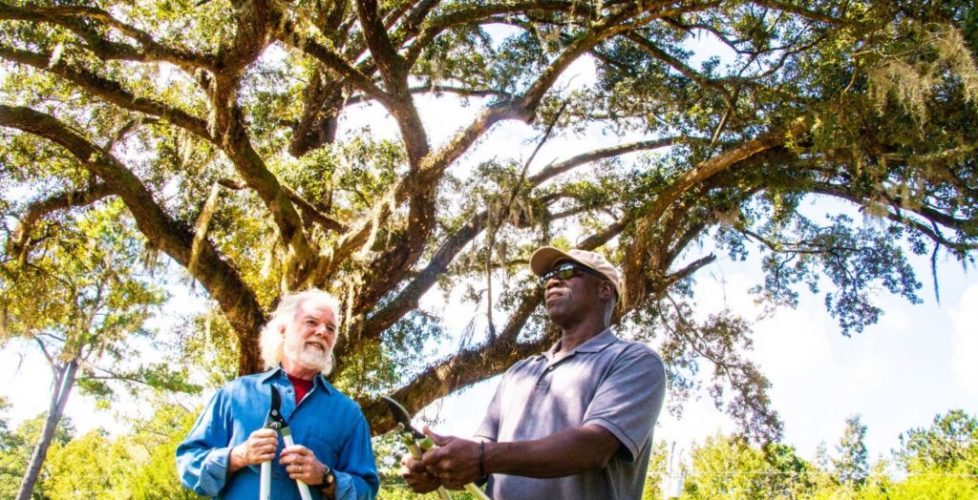A surprising view of “America’s Forests” in new Colorado-produced TV series

If you’re looking to wrap your head around what’s happening in the world right now, try wrapping it around a tree.
That’s the advice of Bruce Ward, a Denver TV producer and longtime outdoors advocate, on the eve of screening a new episode of his series, “America’s Forests.”
“When my family lived in Bailey, we were evacuated because of forest fires three times,” said Ward, founder of the Denver-based nonprofit Choose Outdoors. “That’s pretty scary when they’re literally at your front door with a megaphone telling you to leave now.”
Hosted by Rolling Stones keyboardist and Georgia tree farmer Chuck Leavell, “America’s Forests” premiered a year ago on PBS with a pilot that explored Oregon’s forests for a trio of tales: timber skyscrapers in Portland; adapting to “fire forests” in Bend; and habitat restoration in the Siuslaw National Forest on the Oregon Coast.
The show is presented nationally by Rocky Mountain PBS, with a patchwork of funding that includes grants from the National Forest Service and various nonprofits. Its third episode will screen at the Denver Museum of Nature & Science’s Phipps IMAX Theatre on Jan. 21, with Ward and USDA Forest Service leadership in attendance.
The free event includes a cocktail and hors d’oeuvres reception (starting at 6 p.m.), film premiere and a conversation on the importance of increasing diversity in the great outdoors. Notably, the series’ third episode travels to South Carolina for a look at “the unique history, challenges and successes of three African American forest land owners,” according to PBS.
“Certainly, there are many more stories to tell,” said Ward, who focused on Colorado’s forests for the show’s second episode. “Fifty million acres of dead trees in the west is one of them. But it’s not just mountain pine beetles, spruce epidemics or the alarming decline of aspen trees. We’re facing the unintended consequences of decades of well-intentioned environmental policies — such as putting out every forest fire within 24 hours.”
As Ward’s comments hint, an honest look at fire suppression and the role of the timber industry is also part of the series. That has earned him both praise from business advocates and criticism from environmentalists, given the relatively centrist viewpoint of the series.
“A lot of my friends said, ‘Did you sell out to the timber industry?’ But I don’t have the perspective that they’re just a bunch of (SOBs) destroying the planet. The Nature Conservancy, Rocky Mountain Elk Foundation, National Wild Turkey Federation and Conversation Fund are all working along the lines of what the timber industry has been doing lately.”
It’s also an indication of the wider narrative possibilities in forests beyond the familiar, sun-dappled, slow-motion tributes. Prior to starting Choose Outdoors, Ward and his wife Paula, a landscape architect, spent 15 years building the Continental Divide National Scenic Trail as co-executive directors of The Continental Divide Trail Alliance, a nonprofit they co-founded in 1985.
Ward values forests as intricate cathedrals of nature and refuges of life. But he’s a pragmatist. Use and management are a key part of their preservation, and the clock is ticking.
“I don’t know that there’s anywhere in the country that you could say forests are truly healthy and vibrant,” he said.
When renowned Colorado nature photographer John Fielder began a photo-comparison project with the century-old work of Henry Jackson, for example, he quickly noticed the difference that fire suppression had made in population density.
“A healthy stand of lodgpole pines is about 70 to 80 trees per acre, based on old photographs,” Ward said. “Now, in some of the same places Jackson photographed, you can see 1,000 trees per acre. You used to be able to drive wagons through these forests, but now they call it ‘dog hair’ because it’s so unnaturally concentrated.”
The unique plight and possibilities of forests have prompted Ward, Leavell and their team to produce another half-dozen episodes, with just as many in the planning stages. Once completed, that will give them a shot at regular rotation on the 300 or so national PBS affiliates in the U.S.
So far, about 100 public-TV stations have aired episodes of the show, but without a 13-episode season — the standard minimum in the TV business — hardly anyone will commit to giving it a regular time slot.
Ward’s hopeful people will pay attention outside of Colorado, especially with media-dominating wildfires in California and Australia over the past year.
“As our presenting station, Rocky Mountain PBS have been great in helping air and connecting us through their network with dozens of other stations in a grassroots way,” Ward said. “The biggest impediment right now is Mick Jagger, because the Rolling Stones won’t stop touring. When they’re gone, our host Chuck is gone, so we work around his schedule.”
